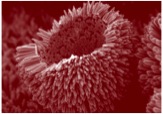The element zinc is essential for all living things in small doses, but is known to be toxic in high doses. This observation is reflected in the results on the toxicity of zinc oxide nanoparticles. In general, zinc oxide particles dissolve very rapidly in liquids, so that zinc ions are always present in addition to the particles. For zinc oxide comparative investigations have been carried out in various test organisms on the action of zinc salts, micro- and nanoscale particles.
Zinc and zinc oxide are known to be antibacterial effective (e.g. in zinc ointments) and consequently zinc oxide nanoparticles inhibit the growth of various bacterial species. It is assumed that the toxicity largely depends on the released zinc ions. Bacterial growth inhibition was enhanced under the influence of light, and was more pronounced for smaller particles compared to larger ones. Oxidative stress and damage to the outer membrane is thought to be a mechanism of toxicity. In addition, zinc oxide nanoparticles damage the genetic material in some types of bacteria. Due to the different sensitivity of individual bacterial species, bacterial communities change in their composition under the influence of zinc oxide nanoparticles. The harmful effect of high doses of zinc can affect the many important functions that bacteria take in the environment, such as the nitrogen and methane fixation .

The general signs of damage of fish due to excessively high zinc concentrations range from developmental delays to the damage of individual organs or the immune system. More detailed studies of the mechanism of action revealed the formation of oxidative stress by zinc oxide particles as a possible cause of toxicity. Some fish species, but not all, internalize zinc oxide nanoparticles and zinc was detected in various tissues (liver, brain, gills). In numerous fish studies, zinc oxide nanoparticles produced stronger effects than zinc ions. In some studies, no difference was found. In any case, a part of the effect is attributed to the dissolved ions, which can obviously be amplified by the particles .

Zinc exerts toxic effects in water fleas. Organic substances that occur naturally in water can reduce the toxic effect of the zinc oxide nanoparticles. Since water fleas filter the water for food intake, nanoparticles enter directly into their bodies, but an efficient excretion from the gut was observed. In water fleas, zinc oxide nanoparticles exerted the same toxic effects as zinc ions. It was also described that the more ions particles release, the more harmful they were.
Similar observations for zinc oxide nanoparticles have also been made in a number of other crustaceans and zooplankton. The effect of zinc oxide nanoparticles and zinc ions did not differ in isopods when the effects were observed at the whole-organisms level .
 The influence of zinc oxide nanoparticles on the growth, reproduction and behaviour of threadworms was comparable to that of zinc ions, however some results also suggest a stronger effect of smaller particles. The particles also cause oxidative stress in threadworms. Light can increase the toxicity of zinc oxide nanoparticles. In earthworms, zinc oxide nanoparticles produce similar effects as in threadworms. However, in this organism, ions have a greater toxicity than nanoparticles .
The influence of zinc oxide nanoparticles on the growth, reproduction and behaviour of threadworms was comparable to that of zinc ions, however some results also suggest a stronger effect of smaller particles. The particles also cause oxidative stress in threadworms. Light can increase the toxicity of zinc oxide nanoparticles. In earthworms, zinc oxide nanoparticles produce similar effects as in threadworms. However, in this organism, ions have a greater toxicity than nanoparticles .
 Zinc oxide nanoparticles are absorbed by mussels and snails and are toxic in high concentrations. Here too, oxidative stress has been demonstrated as a mode of action. Zinc is also toxic to sea urchin embryos. Here the released ions are primarily responsible for the toxicity of the particles. Another study shows that the nanoparticles are more toxic than the ions. In addition, it has been shown that the nanoparticles alter the eggshell, which could facilitate uptake of other contaminants into the embryo.
Zinc oxide nanoparticles are absorbed by mussels and snails and are toxic in high concentrations. Here too, oxidative stress has been demonstrated as a mode of action. Zinc is also toxic to sea urchin embryos. Here the released ions are primarily responsible for the toxicity of the particles. Another study shows that the nanoparticles are more toxic than the ions. In addition, it has been shown that the nanoparticles alter the eggshell, which could facilitate uptake of other contaminants into the embryo.

Claw frog embryos also internalise zinc oxide nanoparticles. The particles trigger oxidative stress, resulting in damage to cells .

Zinc oxide nanoparticles influence the nervous system and lower the survival rate of bees. In jump tails, zinc oxide nanoparticles and zinc ions likewise cause damage in the genome and reproductive capacity. The size of the particles has no influence on the toxic effect. The animals avoid soil contaminated with zinc .
 For algae, zinc is a toxic element, the active component being the zinc ion. Both zinc oxide nanoparticles and coarser particles liberate these ions in different proportions, and are therefore toxic to algae. The extent to which harmful effects depend on the shape and size of particles is evaluated differently. Some studies do not find any dependence, while others observe a dependence on both the shape and the size of the particles. Zinc causes a reduced growth rate and oxidative stress in algae. Zinc oxide nanoparticles are absorbed onto algal cells .
For algae, zinc is a toxic element, the active component being the zinc ion. Both zinc oxide nanoparticles and coarser particles liberate these ions in different proportions, and are therefore toxic to algae. The extent to which harmful effects depend on the shape and size of particles is evaluated differently. Some studies do not find any dependence, while others observe a dependence on both the shape and the size of the particles. Zinc causes a reduced growth rate and oxidative stress in algae. Zinc oxide nanoparticles are absorbed onto algal cells .

Zinc can also be toxic to plants, whereby the individual species show different sensitivity. The ions liberated from the nanoparticles are mainly responsible for plant toxicity. Besides a general growth retardation, the roots of the plants are impaired because they have the first contact with the zinc oxide nanoparticles. A delayed germination was observed for seeds. Zinc is absorbed into plants and is distributed more or less into roots, shoots, leaves and fruits. Zinc oxide nanoparticles also cause the formation of oxidative stress in plants .
Many studies, but not all, attribute the detrimental effects of zinc to the release of ions from the nanoparticles. Overall, particles of different sizes and zinc ions elicit similar symptoms, for example oxidative stress, which has been detected in almost all the organisms studied. The overall toxic potency differs depending on the organisms’ sensitivity.
Additional Literature
- Further evaluated literature for the nanomaterial zinc oxide can be found here (PDF, 85 KB )
 How can I come into contact with this material?
How can I come into contact with this material?



 The influence of zinc oxide nanoparticles on the growth, reproduction and behaviour of threadworms was comparable to that of zinc ions, however some results also suggest a stronger effect of smaller particles. The particles also cause oxidative stress in threadworms. Light can increase the toxicity of zinc oxide nanoparticles. In earthworms, zinc oxide nanoparticles produce similar effects as in threadworms. However, in this organism, ions have a greater toxicity than nanoparticles .
The influence of zinc oxide nanoparticles on the growth, reproduction and behaviour of threadworms was comparable to that of zinc ions, however some results also suggest a stronger effect of smaller particles. The particles also cause oxidative stress in threadworms. Light can increase the toxicity of zinc oxide nanoparticles. In earthworms, zinc oxide nanoparticles produce similar effects as in threadworms. However, in this organism, ions have a greater toxicity than nanoparticles . Zinc oxide nanoparticles are absorbed by mussels and snails and are toxic in high concentrations. Here too, oxidative stress has been demonstrated as a mode of action. Zinc is also toxic to sea urchin embryos. Here the released ions are primarily responsible for the toxicity of the particles. Another study shows that the nanoparticles are more toxic than the ions. In addition, it has been shown that the nanoparticles alter the eggshell, which could facilitate uptake of other contaminants into the embryo.
Zinc oxide nanoparticles are absorbed by mussels and snails and are toxic in high concentrations. Here too, oxidative stress has been demonstrated as a mode of action. Zinc is also toxic to sea urchin embryos. Here the released ions are primarily responsible for the toxicity of the particles. Another study shows that the nanoparticles are more toxic than the ions. In addition, it has been shown that the nanoparticles alter the eggshell, which could facilitate uptake of other contaminants into the embryo.

 For algae, zinc is a toxic element, the active component being the zinc ion. Both zinc oxide nanoparticles and coarser particles liberate these ions in different proportions, and are therefore toxic to algae. The extent to which
For algae, zinc is a toxic element, the active component being the zinc ion. Both zinc oxide nanoparticles and coarser particles liberate these ions in different proportions, and are therefore toxic to algae. The extent to which 